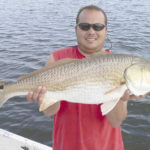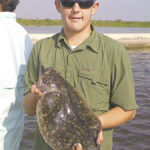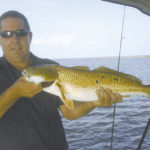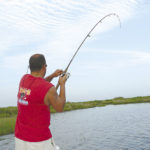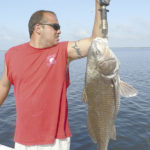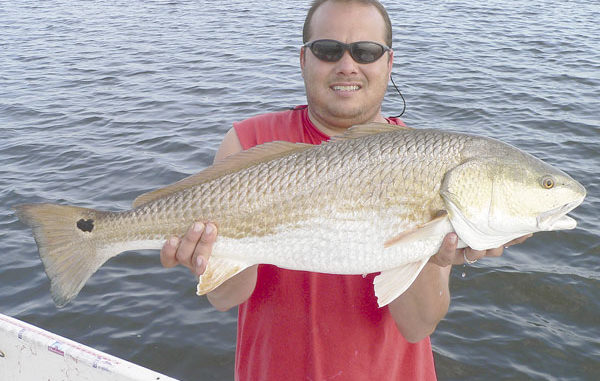
Follow this angling advice to put untapped fish in the boat this month.
“I once gave up fishing. It was the most terrifying weekend of my life.” —Anonymous
This is the time of year you’d normally expect legions of anglers to be out on the water.
The worst of the summer heat and humidity are usually over, and a few fronts try making their way down from the north. The tropics hit their peak of activity and the kids are all back in school.
The word I’d use to describe September is normal. It’s when things get back to a more normal and logical routine — summer vacations are done for another year, we’re back to driving through school zones and our waters have almost entirely reopened for fishing.
Even some tropical activity is normal for us down here in the Gulf South, as long as we don’t get walloped by another of those 100-year storms. We’ve looked down the mouth of that dragon enough for one lifetime already.
But the word normal hasn’t quite registered in the minds of many anglers, who for one reason or other, have yet to return to the water. It’s a fact recently noted by longtime marina owner Joe Bourgeois, over at Joe’s Landing in Lafitte (800-547-6501).
“The whole oil-spill situation has been terrible for all of us, and it couldn’t have come at a worse time,” Bourgeois said. “We were shut off from all the fishing waters for a while, but now just about everyplace has reopened. The water is good, the fish are out there, but the fishermen still seem to be in a holding pattern. A lot of the guides are still working with the cleanup effort, so, no, things haven’t returned to normal down here, at least not yet.”
Bourgeois opened the marina in the 1970s, when the area was nothing but a swamp.
“I don’t know if you were familiar with this area back then, but we literally dug it out of a swamp and built the marina when nothing else was here. All the houses and camps came later,” he said.
Joe grew up fishing the waters of Lafitte, so he’s pretty much spent his entire life (all 80 years of it) working and playing in the abundant waters, and since then he and his son, Sid, and their Joe’s Landing marina have become a fixture in the Lafitte area.
Over the years, they’ve faced a lot of obstacles.
“We had about $600,000 in damage from Katrina, when it passed by and caused extensive wind damage, and then in the past 5 years we’ve had two floods, from Rita and Ike,” Joe said. But with those storms, you returned to the marina and went back to work. You knew what the damage was, and you felt like you could fix it back the way it was or even better.
“But with this oil spill, nobody knows what we’ve really got, or what the long term will hold.
“But all in all, the good times out here have far outweighed the bad times. We’ve had to work hard, long hours and seven days a week. But we’ve enjoyed great fishing and a good life. You don’t make big money in this business, even when times are good, but when times are tough, like now, our bills still have to be paid. And the fishermen, well, they just haven’t returned in any numbers to the water yet.”
But fall is usually a great time for fishing Lafitte, and Bourgeois has high hopes that once the word spreads that the fishing action is excellent and the fish are safe to eat, things will rapidly improve.
You gotta see for yourself.
I arranged to jump aboard a boat with Rusty Helmer (a.k.a. “China”) to see if we could get on some fish recently, and we didn’t have any trouble at all finding a good variety of species, including speckled trout, redfish and drum.
China had a good general plan — we’d scout the shorelines around some of the normal fall hotspots, looking for signs of baitfish or the tell-tale “V” wakes of prowling redfish, and we’d look for birds. We found everything we looked for, and more, and all in a very short period of time.
According to China, the Little Lake area is usually good in the fall, and areas farther south like Coffee Bay, Red Eye and Hackberry Bay are all productive this time of year. Barataria Bay, especially around Manila Village, is also a normal hotspot, but the small wellhead that blew out is keeping that area closed, at least for now.
We patrolled along the shorelines and rocks, keeping a close enough distance to see bait activity, but far away enough so as not to run everything off in the process. Once he spotted something worth investigating, he trolled quietly in. We fished plastics and spoons, but the plastics were the hotter ticket. They paid off best when fished at the various cuts and points, simply tightlined, and the most productive colors were purple/chartreuse, black/chartreuse, or glow/chartreuse. The opening night color produced some good fish as well.
“There’s no shortage of fish, that’s for sure,” China said, reeling in yet another redfish. “Any of these lakes will pay off all this month — Little Lake, Coffee Bay, Bay L’Ours, Three Bayou Bay. Just troll the shorelines and concentrate at cuts and points.”
The one concern China expressed was what the freshwater diversion would be doing in the fall.
“If it’s running wide open, it’ll make the water muddy in some of our usual hotspots, like the Pen, Turtle Bay and Dupont,” he said. “But otherwise, those are spots worth trying as well.”
We saw a good-sized flock of gulls diving over bait in Little Lake, but it was hard to leave the good redfish bite on the bank. We watched them for awhile; the birds stayed at it, and the flock just kept getting bigger, so we finally succumbed to the temptation. China took the boat wide enough around the action so as not to spook the bait, the fish or the birds, and cut the engine well upcurrent from the action.
“It’s important you don’t get anxious and try to run in too close to the birds, because you’ll scatter the bait and the fish,” he said. “If you’re quiet, you should be able to get into the action and stay in it awhile and put some fish in the boat.”
That’s exactly what we did. Sure enough, it was trout under the birds, and almost all were keepers. It didn’t take long to put a dozen or so trout in the box before the flock broke up and the school scattered.
Once the school broke up and the action subsided, the pace returned to normal, at least for a few minutes. But we soon saw the flock of gulls reforming about 50 yards away, and China cranked us up and started heading in that direction. About half-way to the birds, China yelled, “Look! Look right in front of us.”
He pointed just ahead of the bow. He killed the outboard as a huge school of bull drum swam right under the boat, clearly visible in the water.
“Throw something,” I yelled, as I tossed my plastic cocohoe into the school of big fish. I was prepared for an underwater explosion as the big fish vied over my bait, but to my surprise, they ignored it. I reeled in and cast again, and this time had a taker. China had an immediate hookup, and we both fought our big drum back to the boat.
We’d unhook, take a photo or two, release the fish and recast because the huge school of drum stayed right with us as we drifted. Sometimes you’d make two or three casts right in front of the big fish before one would hit it, while other times they’d nail it right away. We played catch and release with the big ugly fish until we tired of the game, and then we turned our attention back to fishing under the birds.
Capt. Gordon Matherne (985-491-3452) also likes to fish the fall months in Lafitte, and Hackberry Bay is where he says he’ll head for trout.
“The big bay is usually teeming with trout in September, and if you don’t mind the long run, is almost a guarantee for success, if there is such a thing in fishing,” he said.
But he also has some closer-in options that he likes to play if the conditions and the fish cooperate.
“I do like to fish around Plum Point in September,” Matherne said, which is best when fished on a east to southwest wind. “When it comes from any of those directions, you can hide behind one side or the other, and the area almost always produces fish, both redfish and trout.
“I also really like to fish the northwest side of Blind Bay and the north side of Bay Dos Gris. I’ll just troll the shoreline, and fish thoroughly at the mouths of cuts for reds and specks.
“The water is shallow, so I’ll use beetles about 1½ feet under a popping cork for the specks, and gold spoons, plastics or even topwaters for reds.”
Matherne says the northwest corner of Little Lake is usually a good spot for reds this month as well.
“There are a lot of great areas to try — Coffee Bay, Bay L’Ours, Brusle Lake at all the cuts and passes. It will be a great month if the freshwater diversion doesn’t flood us out with fresh water, and barring any tropical storms,” he said.
Back at Joe’s Landing, Sid Bourgeois says September actually kicks off some of the best fishing the year, right along with football season.
“It’ll be great from here on out through the reast of the year,” he said. “The waters are finally opened to fishing, the fish are definitely there, the marinas are open, we’ll have some good live bait — all we need now is for anglers to get back on the water. And of course, no more hurricanes or oil spills.”
Sounds logical to me.
Capt. China can be reached at (800) 547-6501. Capt. Gordon Matherne can be reached at (504) 491-3452.
